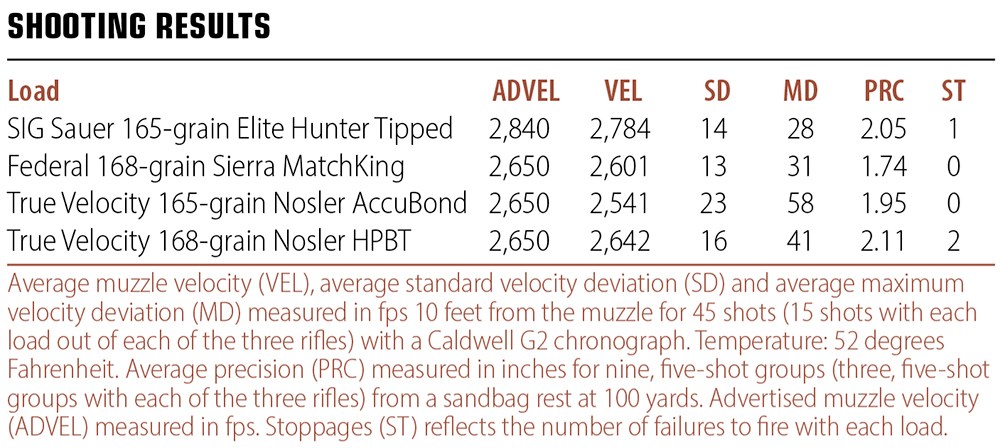True Facts About Composite Ammunition
True Velocity is offering centerfire ammunition that utilizes a polymer as opposed to a brass cartridge case.
When the Glock was introduced, it was met with skepticism. Most shooters wondered what kind of fool would make a gun out of plastic. Now, most new handguns are manufactured with a polymer grip frame. What everyone knows now, but didn’t then, was that the important parts of the Glock are steel. A new Texas-based company called True Velocity is applying Glock’s visionary handgun design to centerfire ammunition. Just as many wondered about the Glock back in the 1980s, you’re probably now wondering why anyone would want to make plastic ammo? Well, there are a couple of reasons.
True Velocity manufactures ammunition that uses a polymer case. Like with the Glock pistol, the important parts are steel. With True Velocity ammunition, the case head—the part of the cartridge that fits against the breech face and where the primer is inserted—is made of stainless steel. The polymer-case body is then fused to this steel-case head. Polymer is lighter than brass; a .308 Win. polymer cartridge will weigh about 27 percent less than a brass one. That amounts to 108 grains. That percentage is a big difference, but 108 grains is not a lot of weight. That is, until you’re shipping or carrying a lot of ammunition.
- Activate Your Own Stem Cells & Reverse The Aging Process - Choose "Select & Save" OR Join, Brand Partner & Select Silver To Get Wholesale Prices
- Get your Vitamin B17 & Get 10% Off With Promo Code TIM
- How To Protect Yourself From 5G, EMF & RF Radiation
- Protect Your Income & Retirement Assets With Gold & Silver
- Grab This Bucket Of Heirloom Seeds & Get Free Shipping With Promo Code TIM
- Here’s A Way You Can Stockpile Food For The Future
- Stockpile Your Ammo & Save $15 On Your First Order
- Preparing Also Means Detoxifying – Here’s One Simple Way To Detoxify
If you’re transporting a million rounds across the continent or to another country, like the military often does, that difference of 108 grains per cartridge equates to almost 8 tons. If you’re a Soldier carrying 200 rounds of ammunition, that 108-grain difference equates to 3 pounds. That means a Soldier could carry 272 rounds of polymer-case ammo .308 Win. ammo for the same burden as 200 rounds of brass-case ammo. That’s a 36-percent increase in available ammunition for the individual Soldier.
Also, according to True Velocity, a polymer case serves as a heat insulator as opposed to a heat conductor like brass. This helps keep the temperatures inside firearms lower. Lowering the operating temperature of a firearm is a good thing, no matter the situation, but it is especially important in military applications. In combat and even in training, military firearms can be exposed to excessively high-round counts over a very short period. Less internal heat helps maintain stoppage-free operation, reduces potential for breakage and increases the life of the firearm.
None of this matters if polymer-case ammunition is not reliable or cannot deliver on-target precision. True Velocity provided some .308 Win. ammunition loaded with 168-grain Nosler HPBT Custom Competition and 165-grain Nosler AccuBond bullets. I tested these loads in a Steyr Scout rifle with a 19-inch barrel, in a custom-configured AR-10 with a 16-inch barrel and in a Remington 700 with a 24-inch barrel that had 5R rifling and was outfitted with a suppressor. With the help of a friend who’s a sniper on a local SWAT team, we compared the performance of the True Velocity ammo against the nickel-plated, brass-case SIG Sauer 165-grain Elite Hunter Tipped load and the brass-case Federal 168-grain Gold Medal Sierra MatchKing load. We fired three, five-shot groups from a sandbag rest at 100 yards with every load, and out of each rifle.
We fired a total of 180 rounds and experienced three malfunctions. One round of the SIG Sauer 165-grain Elite Hunter Tipped ammunition caused a class-three stoppage in the AR-10. The other two malfunctions involved the True Velocity 168-grain HPBT load. Two of those rounds failed to fire. One failed in the Steyr Scout rifle and the other in the Remington 700. We attempted to fire both rounds two additional times. They simply never went bang.

The True Velocity 168-grain load produced velocities closer to advertised than any of the other loads tested. It showed a variation of only 8 fps between the advertised and the average actual velocities we recorded. The True Velocity 165-grain load showed the largest variation, at 109 fps. The average standard velocity deviation for all True Velocity loads, in all three rifles, was 19.5 fps. The average for the two brass cased loads was 13.5 fps. As for maximum velocity deviation, the average for the two polymer-case loads was 49.5 fps and the average for the two brass-cased loads was 29.5 fps.
Of all the loads tested, the Federal 168-grain Sierra MatchKing delivered the smallest average group size at 1.74-inches for nine, five-shot groups out of the three different rifles. The second-best performing load was the True Velocity 165-grain Nosler AccuBond, which averaged 1.95 inches out of all three rifles. Overall, the brass-case loads averaged 1.89 inches and the True Velocity loads averaged 2.03 inches. That’s a difference of only .14 inch, which is negligible and could have been induced by human error.
The firing of 90 rounds of an ammunition type through three very different rifles does not constitute a definitive conclusion. From the standpoint of velocity and precision, I would consider the performance of the True Velocity ammo equal to that of the brass-case loads, especially considering that every rifle has its likes and dislikes when it comes to ammunition. Except for the two failures to fire (in two different rifles) with the one True Velocity load, I would not give a practical performance advantage to either ammunition type. I would also add that my assistant and I both felt the polymer-case ammunition cycled smoother than the brass-case loads. This was not something we could measure; it was only a feeling.
Based on this test, I see little practical advantage for True Velocity polymer-case ammunition in the civilian world. It currently performs no better than conventional brass-case ammo. It’s also—at least on the commercial market—42 percent more expensive, and the fired cases cannot be reloaded. However, this technology, which by any measure is rather amazing, is in its infancy. We can only expect quality to improve, especially if the military gets on board, and the military application is where this stuff has a lot of appeal. It substantially reduces transport cost, greatly increases the amount of ammunition the individual soldier can carry and it should also extend the service life of military small arms. I imagine, with the potential to make the polymer cases in a variety of colors, it would also offer a unique way to easily differentiate between different types of loads for the same cartridge, both on and off the battlefield.
Does the future of the civilian sport shooter include polymer-case ammunition? I think at some point it will be a viable option, and maybe even a better one. We could possibly even see firearms specifically designed to fire nothing but polymer-case ammunition. Additionally, because of the way this ammunition is made, the potential exists to create more precise cartridge cases, and even cases that could increase ballistic performance. The future of firearms is indeed in the ammunition we shoot, and the technology True Velocity is using is possibly a glimpse of what’s to come.
Article by RICHARD MANN














